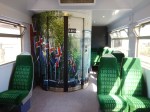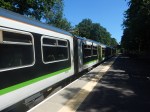Reinstatement Of The Abbey Line Between St Albans Abbey And Watford Junction
This is one of the successful bids in the First Round of the Restoring Your Railway Fund.
Over the years on this blog, I have written several times about the Abbey Line, which is one of those lines, that despite very few improvements or modernisation has continued to give good and faithful service.
Objectives Of The Upgrade
Any railway upgrade must meet a series of objectives.
I would suggest the following objectives for the Abbey Line.
- A minimum of two trains per hour (tph)
- High quality reliable trains.
- Step-free stations.
- Zero-carbon operation.
- A solution that will last at least until 2050.
It should also have an acceptable benefit-cost ratio.
Last Year’s Consultants Report
Last year, consultants reported on the Abbey Line. In the June 2019 Edition of Modern Railways, there is an article, which is entitled Abbey Line Passing Loop Proposed, which discusses the proposed solution. This paragraph outlines the core idea in the proposal.
A study undertaken by The Railway Consultancy for ABFLY, the Abbey Line Users’ Group, suggests the platform at Bricket Wood be lengthened such that trains stop at different ends of a single platform, similar to the solution adopted at Penryn on the branch line between Truro and Falmouth, which would help to minimise costs. Infrastructure costs of a loop have been estimated at up to £10million, with the additional costs of running more services adding up to a further £1 million.
I did a detailed analysis of the proposals in Abbey Line Passing Loop Proposed.
This was my conclusion.
There are certainly, several affordable ways to improve the Abbey Line.
My preferred solution would be to go for the Penryn solution, using a fleet of Class 319 trains.
So how does this solution fit the objectives, I set down earlier?
A Minimum Of Two Trains Per Hour
This objective will be met.
High-Quality Reliable Trains
The current Class 319 trains on the route are in excellent condition, despite their age!
A fleet of three would probably do a good job, but a new electric train built specifically for the route could do better.
Class 710 trains, like those used by the London Overground, would offer advantages over the existing trains.
- They have a higher capacity.
- They have a faster acceleration, so this might help in increasing the frequency of the service.
- There could be a battery version, which might mean that the loop would be without electrification.
- They are walk-through trains, which might offer loading and unloading advantages in short platforms.
But they would cost more!
Step-Free Stations
All stations are fully-accessible and as no modifications are proposed to the stations, they will stay that way.
Zero-Carbon Operation
Provided the electricity for the route and the trains is produced by renewable electricity, the operation will be zero-carbon.
A Solution That Will Last Until 2050
The UK is committed by law, to be carbon-neutral by 2050.
For that reason any solution must last until that date.
This solution should last, as trains, electrification and signalling should be replaceable with new, at any time.
Conclusion
This project could be shovel ready, if Network Rail have done their track and signalling design.




[…] Reinstatement Of The Abbey Line Between St Albans Abbey And Watford Junction […]
Pingback by Restoring Your Railway Fund « The Anonymous Widower | May 24, 2020 |
https://www.railnews.co.uk/news/2020/05/25-monday-essay-off-the-rails.html speculates on reopening the connection between the Abbey line and the Midland line. I’ve just looked on the OS map, and it still shows the first part of this at How Wood. Using your ‘helicopter’, there don’t appear to be any obstacles on the route. This seems to me a very worthwhile proposal.
The other possible connection on the Abbey line is the old link to Hatfield, now a cycle path called the Alban Way, which I walked not so long ago. A connection to the Midland line would be a tight curve, but you could conceivably move City stn to where the lines cross.
I suspect that this isn’t the reinstatement referred to here, but the Abbey line does not have to be a dead end.
Comment by Peter Robins | May 25, 2020 |
There may be possibilities, but looking at what you say and the Railnews article, the first priority would be to increase the base capacity of the Abbey Line.
And to increase the capacity, there needs to be a solution to Bricket Wood. The solution proposed based on that at Penryn seems to be the best to me.
Once it is sorted other ideas might be developed.
Comment by AnonW | May 25, 2020 |
of course, but increasing the capacity isn’t a ‘reinstatement’. The DfT page should probably say ‘reinstatement of passing capability’ or some such.
In fact, looking more closely at the Hatfield line, it goes along a street through some new housing just before the crossing, and the only alternative would be through a golf course. That probably rules that out. A pity, as the 2 lines are only some 700m apart at that point.
Comment by Peter Robins | May 25, 2020 |
Would there be any possibility to use a tram train (or complete replacement with trams), to bring the line more into the town and onwards to Hatfield?
An obstacle could be some of the hills on town centre approaches so some creative routing might be required or a multi modal solution using an EV bus into the town coordinated with train schedule
Comment by MilesT | May 25, 2020 |
I walked from Abbey to City stn a couple of years ago (late weekday morning IIRC). I was planning on catching a bus, but the streets were chockablock, and it was quicker to walk (15-20 mins). I think tram-trains are only suitable for streets that are wide enough to take them (or of course you remove the traffic). Historic town centres like this aren’t really suitable (they’re not really suitable for modern traffic either).
Comment by Peter Robins | May 25, 2020 |
Tram-trains like those in Sheffield or Karlsruhe would be a possibility, as the Class 399 tram/trains are only really an electric multiple unit, that can also do street running. But again, sort out Bricket Wood first.
According to a driver I spoke to in Sheffield, the 399s have bags of grunt and take the not-inconsiderable hills in the city with ease. The St. Albans hill would be a piece of cake.
Comment by AnonW | May 25, 2020 |
the user group’s post is at http://www.abfly.org.uk/2020/05/abbey-line-passing-loop-to-receive-government-funding-to-further-develop-plans/ and includes a link to the Watford MP’s views. They also mention the possibility of through trains to Euston, though I can see a problem with that being crossing from the northbound line, as there don’t appear to be any points, let alone under/overpasses.
Comment by Peter Robins | May 25, 2020 |
[…] See Reinstatement Of The Abbey Line Between St Albans Abbey And Watford Junction […]
Pingback by Restoring Your Railway: Successful Bids « The Anonymous Widower | December 10, 2020 |
I have a problem with everything I read about the various proposals on The Abbey Line.
Firstly, it is lightly used.
Secondly, many of the 319’s currently in service on this line are NOT in good condition. There are regular breakdowns due to failure of various components that requires the regular attendance of a Siemens engineer, at least on most of the morning services.
Thirdly, the end to end journey time is 16 minutes.
The line speed is 50mph and there is a 20mph restriction on the approach to (and departure from) Watford Junction. If the line speed was improved and units with greater acceleration/braking capabilities were used, it could be possible to have a regular 2tph service using 1 unit to do away with the bizarre 47min interval service that is currently on the line. The business on the line simply does not justify 2 units. It would probably be better (and cheaper) to employ 2 drivers to help keep a 30 minute frequency than it would to maintain a 2 train service.
Comment by Andrew Bruton | December 11, 2020 |
There are several of these shuttle lines in the UK. Slough and Windsor Central, Romford and Upminster, Bromley North and Grove Park etc.
The obvious thing is probably to semi-automate these lines, in a manner similar to the Victoria Line. One train would work the line and at each stop, once the operator is satisfied, that all passengers are where they want to be, they would push a button and the train would move to the next station. The driver would monitor everything using CCTV and have an override to stop the train.
Comment by AnonW | December 11, 2020 |